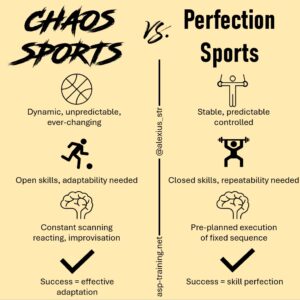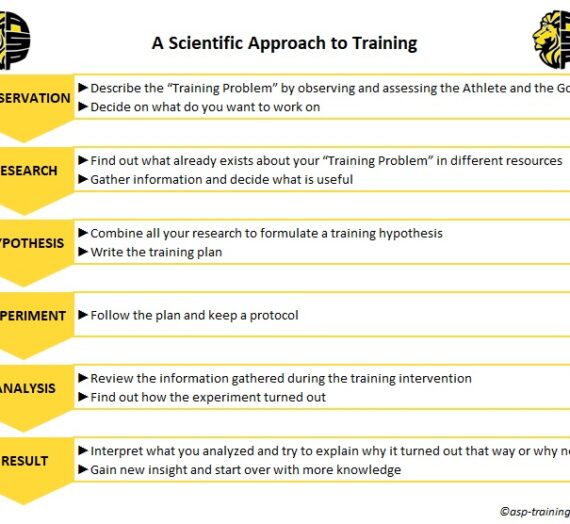In the world of sports, not all sporting events place the same demands on athletes. Broadly (and oversimplified) speaking we can divide all competitions into two categories: Sports of Chaos and Sports of Perfection. Even though both demand elite physical preparation, their inherent difference of structure has influence on how success and performance are measured and ultimately on how athletes train. This, obviously, can have implications on how to structure and design a Strength and Conditioning program.
The Nature of Chaos and Perfection Sports
Chaos Sports (e.g. Football, Basketball, Tennis, etc…) are dynamic and defined by constant unpredictability: Athletes must read and react, anticipate the opponents’ moves and adjust position accordingly. A basketball player, for example, never performs the same sprint twice: Sometimes it’s a breakaway, sometimes a player must run back after the team loses the ball, sometimes they need to accelerate out of a shuffle or a change of direction. The environment changes second by second and the actions of teammates and opponents as well as the randomness of the bouncing ball create the need for constant adjustment.
By contrast, Perfection Sports (e.g. Athletics, Gymnastics, Weightlifting, …) are characterized by reproducibility. Athletes must be able to precisely execute rehearsed movement patterns trying to come as close as possible to an ideal form. The real competition is against the laws of physics first, then only against your direct opponent. A weightlifter trains to execute a snatch with precision down to bar path and joint angles when on the platform.
The perfection athlete’s success does not depend on adapting in real time, but on extremly well execute a certain skill while the chaos athlete doesn’t need one perfect movement rather than many “good enough” solutions while under pressure.

Three Implications for Strength and Conditioning Training
Variability vs. Consistency
In Chaos Sports athletes benefit from exposure to a wide range of different movement patterns, speeds and forces. As success depends on various physical, technical and tactical skills, S&C Coaches often try to make athletes fast, strong and resilient across many scenarios and there are a variety methodologies and exercises to do so. The result of S&C training for Chaos Sports is a robust, well-rounded athlete that can cope with the ever-changing environment in the best possible way. Think of “Fill all the Buckets” popularized by Mike Boyle.
In Perfection Sport the direct transfer to target skill should be the focus: The physical training works to support the technical mastery of the precisely defined competition skill: Strength and Conditioning and Technical Training are often very close to each other, sometimes even the same. Effective exercises often resemble the competitive event and are carefully chosen and planned and consistently done. Think of Bondarchuk’s Framework for classification of exercises.
Periodization and Planning
Perfection and chaos sport events are often organized in a different way:
Training and competition schedules of a perfection Sports are mostly built around peaking your performance at specific meetings. Training can often follow a more traditional periodization model with different, distinct phases (General Preparation, Specific Preparation, Competition). Performance depends on arriving at a precise technical and physical peak at the right moment.
Chaos Sports on the other hand are often played in a league mode with long seasons and frequent games. Physical preparation more often than not has to occur parallel to an on-going season and must account for athletes’ fluctuating readiness and recovery. Periodization and planning often is more flexible as neither the “load” of a competition nor the athletes’ response to it can be predicted in advance. While some competitive events may be more important than others, success often depends on performing on a high level every week.
Injury Profiles
One of the most important (yet ultimately impossible) tasks of an S&C Coach besides improving performance, is to prepare an athlete in such a way that the risk of injury is as low as possible and the athletes can actually do their sport. In perfection sports, the (repetitive) high stress on certain structures during the event/ training combined with little margin for compensation of the physicality of the tasks increase the risk of overuse injury. The body itself has to be so fine-tuned to the task (e.g. low % Bodyfat for jumpers) that the risk of going pushing it too far is always there. In Chaos Sports au contraire, the unpredictability which is the nature of the sport is a risk factor itself. While overuse injuries exist, there is a higher rate of contact injuries and injuries because the sport “forced” the body to a position it cannot control anymore (e.g. ACL tears after a change of direction on football). While athletes are generally very fit, success is less dependent on perfecting the body so some injury risk factors like RED-S might be less prevalent in chaos sport populations.
The Middle ground
Of course, sports are neither purely chaos nor perfection. Good coaching acknowledges this continuum: A tennis serve (perfection skill) must be executed in the chaos of a match. Pole Vault might be a Perfection Sport, yet in competition the weather might add some unpredictability. As a Coach it might help to look to the sport through the lens of chaos: The more chaotic an environment, the more athletes need robustness and adaptability and the more a sport tends to be perfectionist the more athletes need precise strength qualities. Still, probably it always needs a little bit of both. Some strive for perfection in the veil chaos and some acceptance of chaos in the pursuit of perfection.


